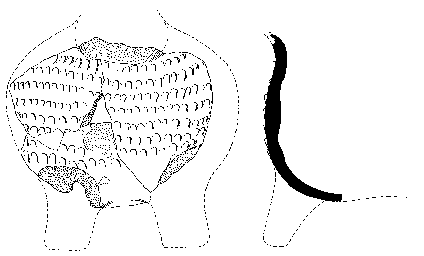 Bulletin
4, 1998
Bulletin
4, 1998
Medieval Pottery at Portmahomack
A Preliminary Assessment 1999
Derek Hall
The excavation of Tarbat Old Church produced a small group of pottery amounting to about 40 sherds which range in date from the early middle ages to the 19th century. Five types have so far been distinguished:
Grass-marked ware
This fabric is commonly recovered from excavations in the Northern Isles and is normally assigned an early medieval date (MacAskill 1982a, 405). Hand-made pottery very similar to this, known as craggan ware was being made as late as the 19th century in the West Highlands and the Hebrides, but is normally in identifiably modern forms such as cups and tea-pots (Quail 1979, 39).
East Coast Redware (Fig 9, nos 1-4)
Fifteen years of archaeological excavations in the Scottish east coast burghs have identified this type of red fabric with a green glaze as forming a tradition of native pottery production apparently dating from the 13th to the 15th centuries (Hall 1996, 126). The assemblage from the church excavations is dominated by this fabric. The Tarbat fabric is much grittier and redder than other examples, and the glaze is of a much higher quality than normal and very lustrous, but it does exhibit the purple wash under the glaze which is typical. The majority of sherds are from glazed jugs (nos 1-3), however in this assemblage there are two sherds from cooking pots and a rim sherd which is probably from a chafing dish (no 4).
The Portmahomack redware seems to belong with similar fabric found at Inverness (McAskill 1982b, 355-368) and more recently in Dornoch (Hall 1998b).
Yorkshire (Scarborough) Ware (Fig 9, no 6-7)
Vessels in these distinctively glazed fabrics from Yorkshire kilns are the most common imports in the east coast burghs during the 13th and 14th centuries (McCarthy and Brooks 1988, 227-252). Five of the six sherds in this fabric are from the same aquamanile (no 7; McCarthy and Brooks 1988, 228, fig 651).
China (Fig 9, no 8)
There was one sherd from a china teacup that has the remains of a stamped 'heart' decoration around the rim. This dates to the 18th or 19th centuries.
Tile
There are two pieces of green glazed floor tile (from context 1013, Int 22)
 1 17/189 |
 217/461 |
 322/8 |
 417/164 |
 520/106 |
 617/7 |
 717/318 |
 820/281 |
Figure 9: Examples of medieval and post-medieval pottery from the church
excavations,
(Drawn by Trevor Pearson)
NEXT: Early Medieval Artefacts
BACK: Eighth Century Coin
Last updated 10 October, 2003.
Contact the Tarbat Discovery Programme


